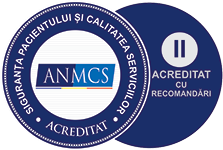INFORM YOURSELVES CAREFULLY!
SEE YOUR DOCTOR IMMEDIATELY IF YOU EXPERIENCE SIMILAR SYMPTOMS!
Diabetes mellitus is a very common syndrome, with about 200 million people currently suffering from it. In Romania, at the beginning of 2002, there were more than 360 000 sufferers. Diabetes mellitus has been known since antiquity, its manifestations being described in the Ebers Papyrus – 1500 BC. In 1889 the link between DZ and the pancreas was proven. In 1921 insulin is discovered by the Romanian scientist Nicolae Paulescu, and in 1922 it is first administered to humans. In 1955 the era of oral anti-diabetic drugs begins, and in 1963 the synthesis of insulin is achieved.
Diabetes mellitus is a metabolic disease with a chronic course, due either to absolute or relative deficiency of effective insulin or to insulin resistance, which causes first of all disturbance of carbohydrate metabolism, followed by disturbance of lipid, protidic, hydromineral and acid-base metabolism. It is the most common metabolic disease, affecting about 5% of the general population in developed countries (yet more than 50% of cases remain undiagnosed).
Classification
Type 1 diabetes mellitus (absolute insulin deficiency through beta-cell destruction): immune-mediated; idiopathic.
Type 2 diabetes mellitus (ranging from predominantly insulin-resistant with relative insulin deficiency to predominantly secretory deficiency associated with insulin resistance).
Other specific types: genetic defects of beta-cell function; genetic defects of insulin action; diseases of the endocrine pancreas; endocrinopathies; toxic or drug-induced diabetes mellitus: infection-induced diabetes mellitus; other immune-mediated forms:-stiff-man syndrome; -insulin receptor ac; other genetic syndromes associated with diabetes mellitus.
Gestational diabetes mellitus
Etiopathogenesis
DM type 1 (insulin-dependent) The majority of cases would be based on an autoimmune inflammatory process with selective destruction of Langerhans beta cells, with preservation of glucagon-secreting alpha and somatostatin-secreting gamma cells. This process would occur preferentially in genetically predisposed individuals. Environmental triggers could be viral (e.g. urlian, measles, epidemic hepatitis, Epstain-Barr, coxsackie, cytomegalovirus) or toxic (including food).
DM type 2 (non-insulin-dependent) The hereditary and collateral character of DZ type 2 is demonstrable in many cases, but family aggregation is explained by both genetic factors and by the transmission of a risky lifestyle, characterized by unhealthy eating habits and neglect of physical activity (sedentary lifestyle): heredity; harmful vicious habits (high calorie intake, excess concentrated carbohydrates, excess fat); sedentarism; stress; chemical factors: food; alcohol, colourings, preservatives, stabilisers; drugs: hormones (corticoids, contraceptives), thiazide diuretics, tricyclic antidepressants; industrial or household toxins (pesticides).
AFFIRMATION OF THE EXISTENCE OF DIABETES:
- occasional detection of a blood glucose value above 200 mg/dl associated with polyuria, polydipsia and unexplained weight loss;
- fasting blood glucose over 126 mg/dl, last lunch taken more than 8 hours before;
- blood glucose over 200 mg/dl 2 hours after ingestion of 75 g of glucose.
Either of these ways is sufficient, but diabetes is only affirmed if it is confirmed by another determination on another day. The degree of difficulty of affirming the diagnosis depends on the type of diabetes and its clinical form.
Diagnosing the type of diabetes
TYPE 1 (insulin-dependent) corresponds to the juvenile type (mild diabetes) in older classifications. Onset: usually at a young age, under 30 (hence the name juvenile diabetes). Prevalence: About 0.5%. Clinical: triad – polyuria, polydipsia, polyphagia. Inappetence, asthenia, weight loss, tendency to ketoacidosis. Genetic: associated with HLA groups; concordance in twins 40-50%. Immunological: presence of circulating anti-insulin antibodies in more than 50% of cases; predisposition to associated autoimmune diseases. Therapeutic: insulin dependence.
TYPE 2 (insulin-independent) corresponds to maturity diabetes (diabetes mellitus) in older classifications. Onset: usually in adulthood (after age 40). Prevalence: about 4.5%. Clinical: often hyperweight (80% of patients); marked tendency to angiopathic complications; rarely decompensates. Genetic: not associated with HLA groups; thought to be a genetic mutation affecting insulin synthesis; concordance in twins 95-100%; autosomal dominant transmission. Immunological: Circulating anti-insulin ac are rarely present (less than 10%). Therapeutic: insulin is rarely (and only temporarily) needed.
Diagnosis of complications:
A. Acute: metabolic: acidocetozoic coma; hyperosmolar coma; hyperlactacidemic coma; hypoglycaemic coma; infectios: bacterial; mycotic.
B. Chronic (degenerative): retinopathy; glomeruloscleroza; arteriopathy; neuropathy; heart disease; periodontal disease; osteoarthropathy; cataracta; neuropathy; necrobioza lipoidica.
Treatment
Therapeutic objectives: metabolic normalization; prevention of hypoglycemia and other iatrogenic complications; ensuring a lifestyle as close to normal as possible; ensuring a lifespan as close to normal as possible. Achieving these objectives requires: balancing diabetes, with normalisation of biochemical parameters; maintaining these parameters within normal limits or as close to normal as possible; improving or even curing complications.
Hygiene and dietary treatment
Physical exercise (running, gymnastics, walking or cycling, swimming, etc.) has certain beneficial effects: it improves insulin sensitivity, normalising the diabetic’s intracellular metabolism; it lowers total cholesterol and plasma triglycerides and increases HDL cholesterol, thus lowering vascular risk; it lowers insulinemia, which also lowers vascular risk.
Diet. Diet is the indispensable therapeutic basis of all forms of DZ and is the best means of balancing the disease. The aim of the diet is to ensure a rational intake of food principles, both quantitatively (energy-calorie intake) and qualitatively (balancing food principles). Conditions: distribution over lunches (according to daily activity, avoiding intermeal carbohydrate gaps – usually 3 lunches and 2 snacks); regularity of feeding (avoiding variability of insulin requirements); type of feeding (according to local socio-cultural particularities).
Medicinal treatment
The drug arsenal comprises 3 categories of drugs: insulins; sulphonamides; biguanides.





 Română
Română English
English